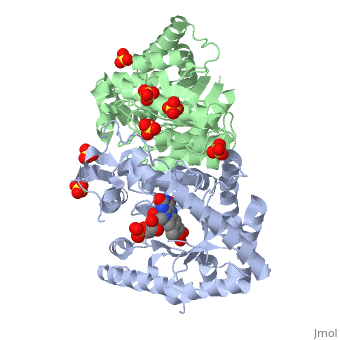3fgc
From Proteopedia
Crystal Structure of the Bacterial Luciferase:Flavin Complex Reveals the Basis of Intersubunit Communication
Structural highlights
FunctionLUXA_VIBHA Light-emitting reaction in luminous bacteria. Evolutionary ConservationCheck, as determined by ConSurfDB. You may read the explanation of the method and the full data available from ConSurf. Publication Abstract from PubMedBacterial luciferase from <i>V. harveyi</i> is a heterodimer composed of a catalytic alpha subunit and an homologous but non-catalytic beta subunit. Despite decades of enzymological investigation, structural evidence defining the active center has been elusive. We report here the crystal structure of <i>V. harveyi</i> luciferase bound to FMN at 2.3 A. The isoalloxazine ring is coordinated by an unusual <i>cis</i> Ala-Ala peptide bond. The reactive sulfhydryl group of Cys 106 projects toward position C-4a, the site of flavin-oxygenation. This structure also provides the first data specifying the conformations of a mobile loop that is crystallographically disordered in both prior crystal structures [Fisher, A. J., Raushel, F. M., Baldwin, T. O., & Rayment, I. (1995) Biochemistry 34, 6581-6586; Fisher, A. J., Thompson, T. B., Thoden, J. B., Baldwin, T. O., & Rayment, I. (1996) J. Biol. Chem. 271, 21956-21968]. This loop appears to be a boundary between solvent and the active center. Within this portion of the protein, a single contact was observed between Phe 272 of the alpha subunit, not seen in the previous structures, and Tyr 151 of the beta subunit. Substitutions at position 151 on the beta subunit caused reductions in activity and total quantum yield. Several of these mutants were found to have decreased affinity for FMNH2. These findings partially address the long-standing question of how the beta subunit stabilizes the active conformation of the alpha subunit, thereby participating in the catalytic mechanism. Crystal Structure of the Bacterial Luciferase:Flavin Complex Provides Insight into the Function of the subunit.,Campbell ZT, Weichsel A, Montfort WR, Baldwin TO Biochemistry. 2009 May 12. PMID:19435287[1] From MEDLINE®/PubMed®, a database of the U.S. National Library of Medicine. See AlsoReferences
| ||||||||||||||||||||


